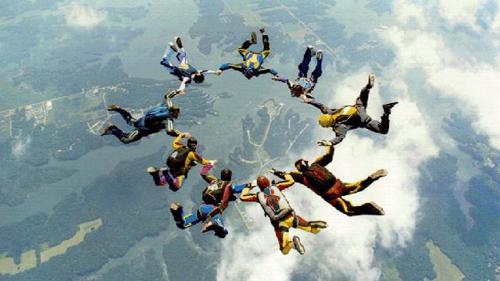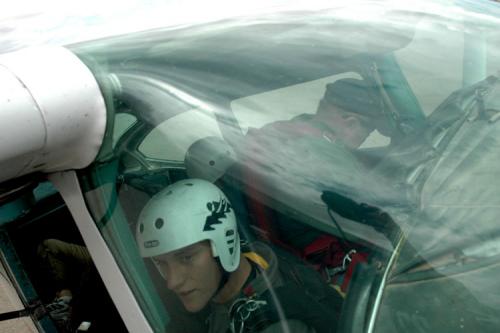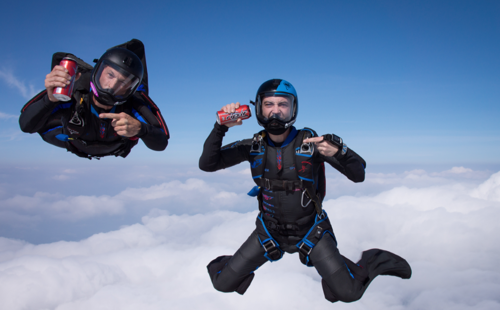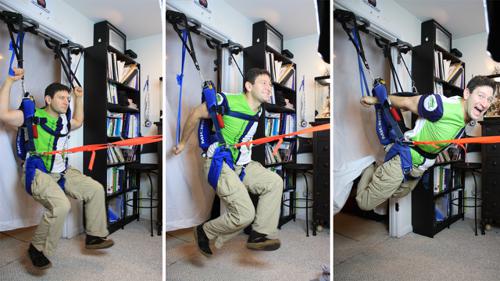The Skydiving Handbook - Chapter 2 (Exits)
Imagine holding your arm out of a car window as you drive down the highway. The wind you feel is caused by your speed through the air rather than by weather. Skydivers call this apparent wind the relative wind, and it is the single most important element of the freefall environment. In fact, it is the only thing you have to work with in freefall, and from the moment of exit until your parachute opens you must think of yourself as a body pilot instead of a regular person, just as when you go swimming you have to leave your land habits behind. Your adventure in the relative wind begins at the moment of exit.
There is nothing particularly complicated about exits and the techniques you use on your first freefall will be the same as those used by skydivers with thousands of jumps. Your exit makes or breaks the skydive, so we spend a lot of time practicing this part of the jump. A weak exit consumes valuable freefall time and puts you in a mental position of having to catch up, adding unwanted stress to your skydive. With a good exit you can get on with your learning and enjoyment at once, finishing the freefall tasks with plenty of time to spare. The two essentials of an exit are presentation and timing. Presentation refers to how you relate to the relative wind. Timing refers to your relationship with the other skydivers. Let's take a detailed look at these aspects of the exit.
The body position we use to maintain a comfortable, neutral position on the wind (the equivalent of floating on water) is an arch. We'll learn more about body position soon, but for now you need to think simply about arching into the relative wind. This means that your hips are pushed forward into the wind, your arms and legs are spread out evenly and pulled back, and your chin is up, creating a smooth curve from head to toe. If you imagine lying face down in a shallow bowl with your arms and legs spread out evenly, you are thinking of an arch. In this position you will naturally face into the wind.
To achieve a good exit, all you have to do is present your arch to the relative wind. Remember, we're on an airplane flying nearly one hundred miles per hour, so the relative wind is from the direction of flight. (When you see photos of skydivers they are usually presenting their arch towards the ground, but that's because they have fallen long enough to be going straight down so the relative wind comes straight up from the ground.) Once you are poised outside of the airplane, start your arch before you let go. Then it is a simple matter to open your hands, pivot into the wind, and you're flying! As you will soon learn, a relaxed arch is much more smooth, stable, and comfortable than a tense one so try not to think of yourself as falling off of an airplane. You're not; you're flying free. A mental image that might help would be learning to swim. You would be more relaxed and alert if you lowered yourself slowly down a ladder into warm water and let yourself float comfortably before letting go than if you jumped off a cliff into cold, dark surf. Think of the air as a friendly environment, slip into it smoothly as you climb out of the airplane, arch, take a deep breath, open your hands, and float off on the wind!
You will note that I didn't say "push off." Until your parachute opens, your last contact with the world of solid objects is the airplane. If you push off, you will have some momentum that will tend to make you go over on your back, just as if you stood with your back to a pool and pushed off of something solid. Just arch and face the wind.
As you leave the aircraft, the relative wind (arrow) is parallel to the ground. In a good arch with your head up, you should see only the airplane and sky rather than the ground during the first second or two of freefall.
Losing forward speed and accelerating downward, the relative wind gradually shifts from parallel to the ground to perpendicular. This transition takes several seconds. You will not be facing the ground until about eight seconds after the exit.
At no time do you look directly down at the ground. Even after the transition is over and you are falling straight down, in a good arch your head is up and your eyes are on the horizon.
The aircraft's speed is about 100 miles an hour. When you leave, you lose some of that horizontal speed and actually slow down for the first few seconds. Then gravity takes over and you gradually accelerate to 110 miles per hour. That's why there is no sensation of sudden acceleration - you only gain ten miles per hour in ten seconds!
Relax, arch, and face the wind is all you really need to do to achieve a stable exit. But remember that you are jumping with other people. For everyone to have a good exit, you also need group timing. Just as a band starts playing to a count, we'll start skydiving to a count. That count, used all over the country, is "ready, set, go!" It should be done with a smooth, even cadence. Because it's noisy outside an airplane, the count should be loud. Finally (think of a conductor with his baton giving a visual count to the orchestra) you, the conductor, need to give the other jumpers a visible count. We have you bring up your left knee on "set" and turn into the wind on go.
Combining these two elements of presentation and timing will almost always result in a smooth exit. Leave out either one, and the exit may funnel, the term skydivers use to describe an unstable formation. Leave both out and a funnel is almost a certainty. But if that happens, don't panic. An arch will fix the problem.
Incidentally, it doesn't affect your stability to dive out of the airplane. As long as you are presenting an arch to the relative wind, you will be stable. Unfortunately it takes most people a while to get used to the idea that the relative wind starts right outside the door. If you walk through an airplane door like you would a house door, you'll present your side or back to the wind and lose stability. In the water, walking doesn't work; you have to swim. Air is the same way - you have to fly through the door, not walk through.
Test Yourself
1. Skydivers on the outside of an aircraft as they prepare to exit are called floaters. The ones inside the airplane who will dive through the door are called divers. Floaters are further divided into front, rear, and center, depending on their position in the door. On an ASP level one jump, the student is the center floater, the reserve side JM is front floater, and the main side JM is rear. Why is the front floater more likely to have a problem than the rear floater if he cannot hear or see the exit count given by the center floater?
2. Novices diving out of an airplane frequently do a half roll and then recover stability facing the aircraft. What could cause this common problem?
Proceed to Chapter 3 (Flying Your Body)







